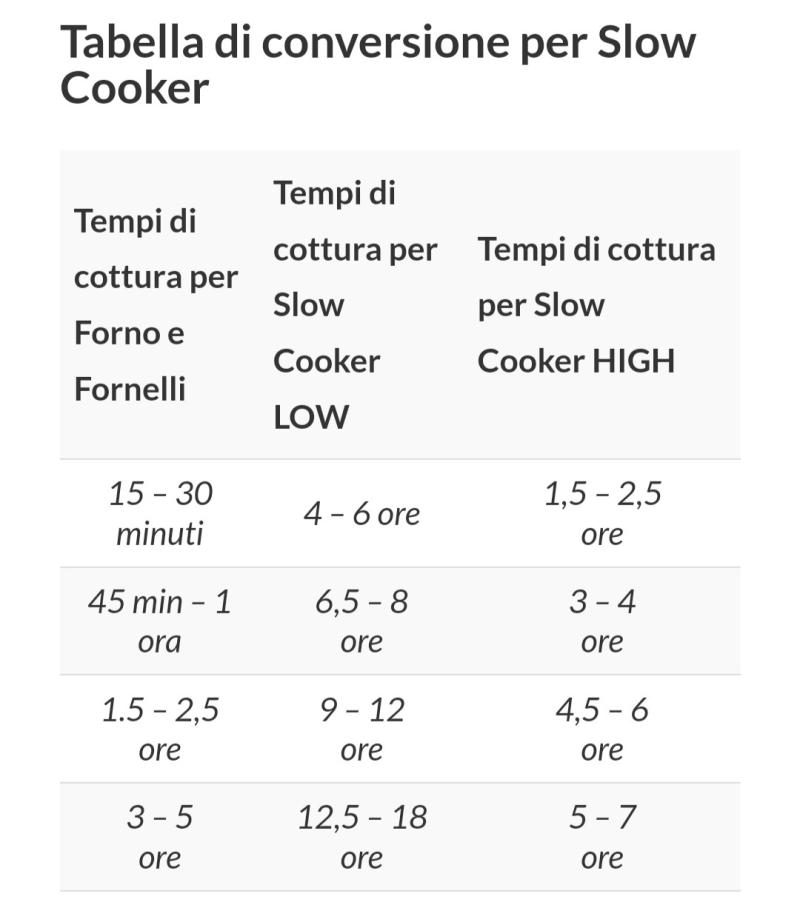Copy Link
Add to Bookmark
Report
Guide to adapt recipes

1

This guide is designed to help you adapt your own and other recipes for your slow cooker. Many of the normal preparatory steps are unnecessary when using your slow cooker.
In most cases all ingredients can go into your slow cooker at once and cook all day.
General:
- Allow sufficient cooking time
- Always cook with the lid on
- For best results and to prevent food from drying or burning, always ensure an adagiate amount of liquid is used in the recipe
| RECIPE TIME | COOK ON LOW | COOK ON HIGH |
| 15 - 30 minutes | 4 - 6 hours | 1½ - 2 hours |
| 30 - 45 minutes | 6 - 10 hours | 3 - 4 hours |
| 50 minutes - 3 hours | 8 - 10 hours | 4 - 6 hours |
PASTA AND RICE
- For best results, use long grain rice unless the recipe states otherwise. If the rice is not cooked completely after the suggested time, and an extra 1 to 1+1/2 cups of liquid per cup of cooked rice and continue cooking for 20 to 30 minutes
- For best pasta results, add the pasta to the slow cooker during the last 30 - 60 minutes of cooking time
BEANS:
- Dried beans, especially red kidney beans, should be boiled before adding to a recipe
- fully cooked canned beans may be a substitute for dried beans
VEGETABLES:
- Many vegetables benefits from slow cooking and are able to develop their full flavour. They tend not to overcook in your slow cooker as they might in your over or on your hob
- When cooking recipes with vegetables and meat, place vegetables into the clown cooker before meat. Vegetable usually cook more slowly than meat in the slow cooker and benefit from being partially immersed in the cooking liquid
- Place vegetables near the bottom of the cooking bowl to help cooking
MILK:
- Milk, cream, and sour cream break down during extended cooking. When possible, add during the last 15 to 30 minutes of cooking
- Condensed soups may be substitute for milk and can cook for extended times
SOUPS:
- Some recipes call for large amounts of water/stock. Add the soup ingredients to the slow cooker first then add water/stock only to cover. If a thinner soup is desired, add more liquid when serving
MEATS:
- Trim fat, rinse well, and pat meat dry with paper towels
- Browsing meat beforehand allows fat to be drained off before slow cooking and also adds greater depth of flavour
- Meat should be positioned so that it rests in the cooking bowl without touching the lid
- For smaller or large cuts of meat, alter the amount of vegetables or potatoes so that the bowl is always 1/2 to 3/4 full
- The size of the meat and the recommended cooking times are just estimated and can vary depending upon the specific cut, type, and bone structure. Lean meats such as chicken or pork tenderloin tend to cook faster than meats with more connective tissue and fat such as beef chuck or pork shoulders. Cooking meat on the bone versus boneless will increases the required cooking time
- Cut meat into smaller pieces when cooking with precooked foods such as beans or fruit, or light vegetables, such as mushrooms, diced onion, aubergine, or finely chopped vegetables. This enables all food to cook all the same rate
FISH:
- Fish cooks quickly and should be added all at the end of the cooking cycle during theast fifteen minutes to one hour of cooking
LIQUID:
- it might appear that slow cooker recipes only have a small quantity of liquid in them but the slow cooking process differs from other cooking methods in that the added liquid in the recipe will almost double during the cooking time. If you are adapting a recipe for your slow cooker from a conventional recipe, please reduce the amount of liquid before cooking
Source: https://www.ricetteslowcooker.it/convertire-una-ricetta-tradizionale-per-slow-cooker/














![Dreamcast Ripping Guide v.1.0 [NON CDDA]](https://www.neperos.com/journal_pictures/9f9e53//Dreamcast_p1zio434bb63828b.jpg)















